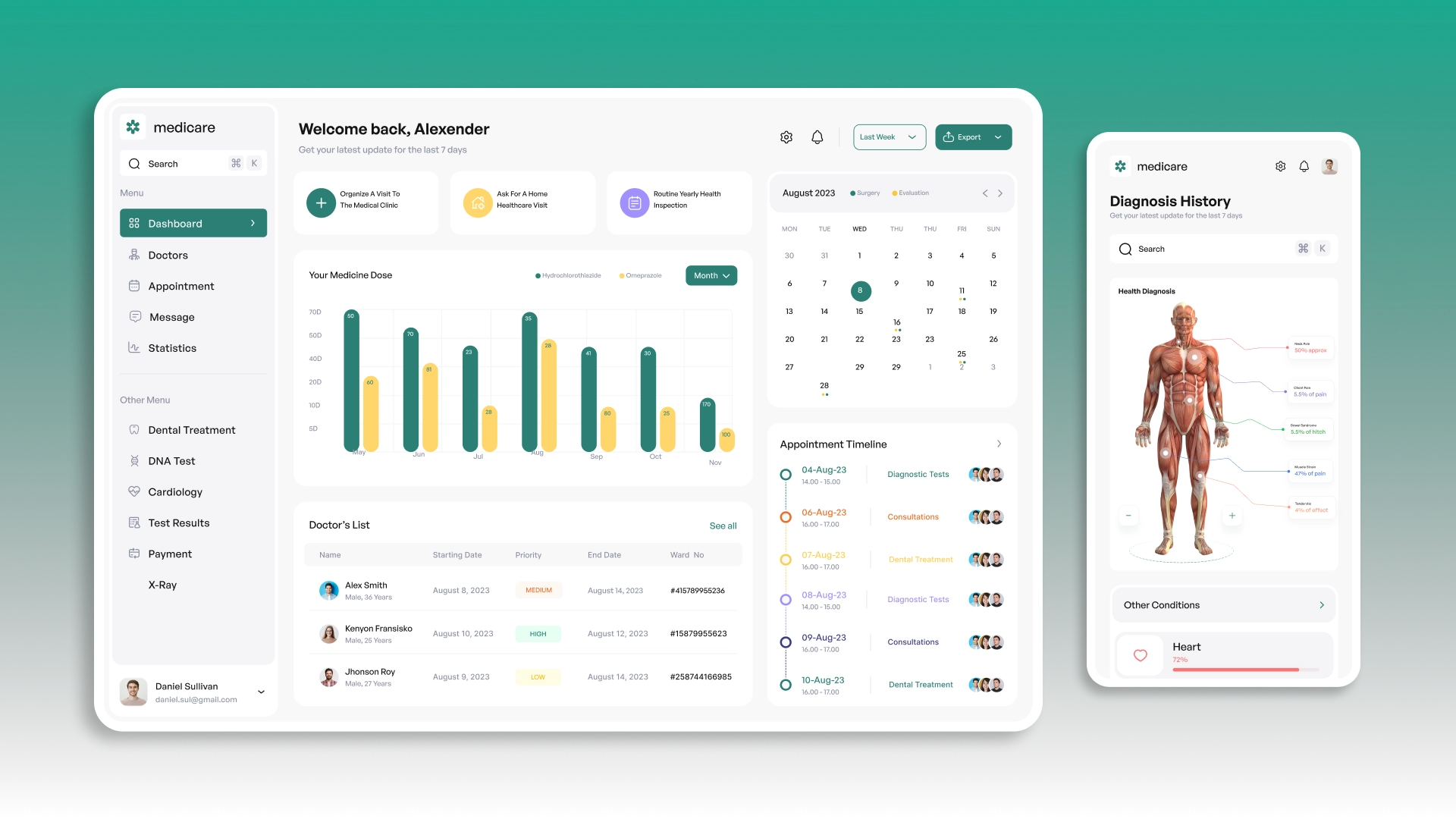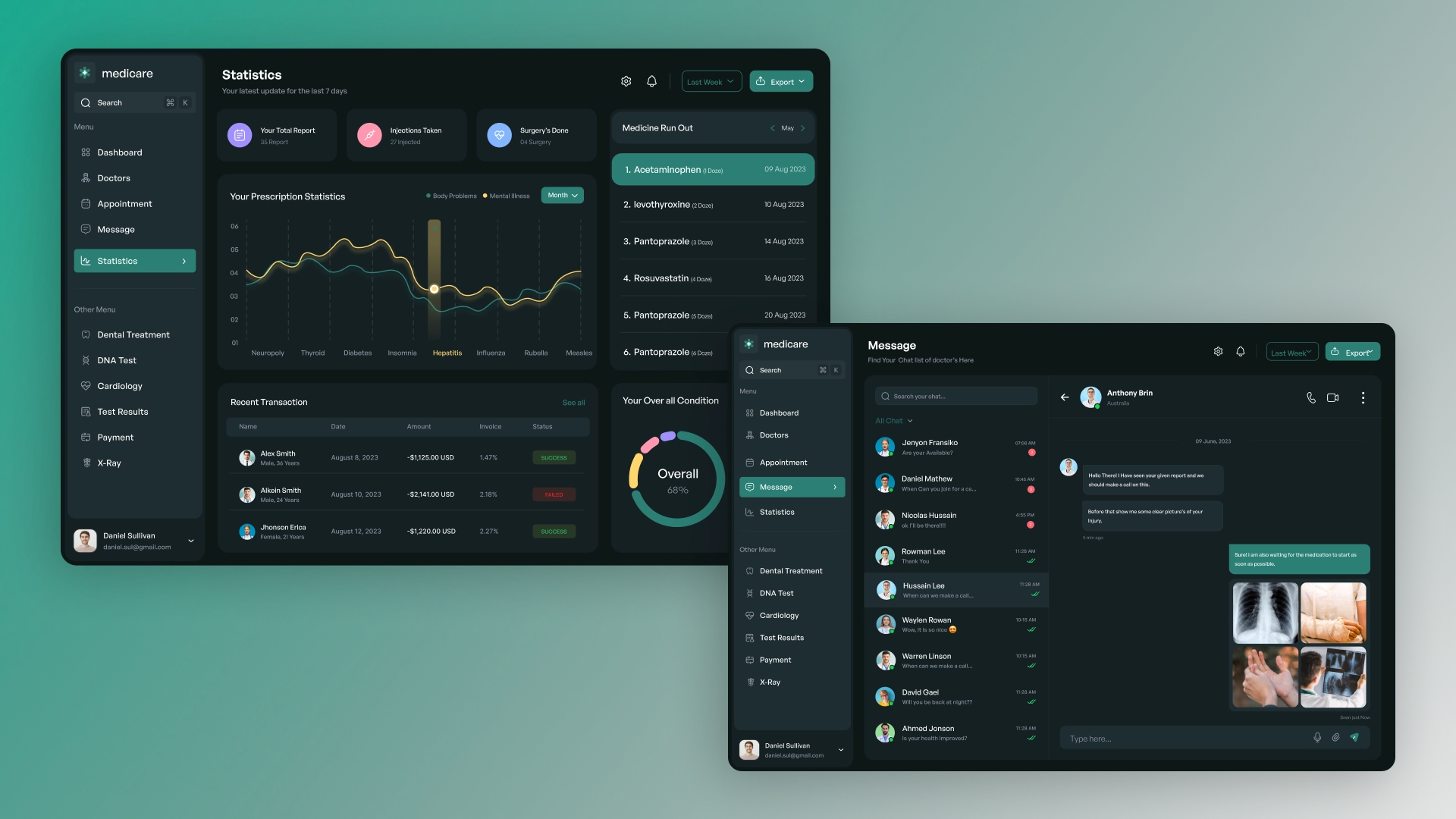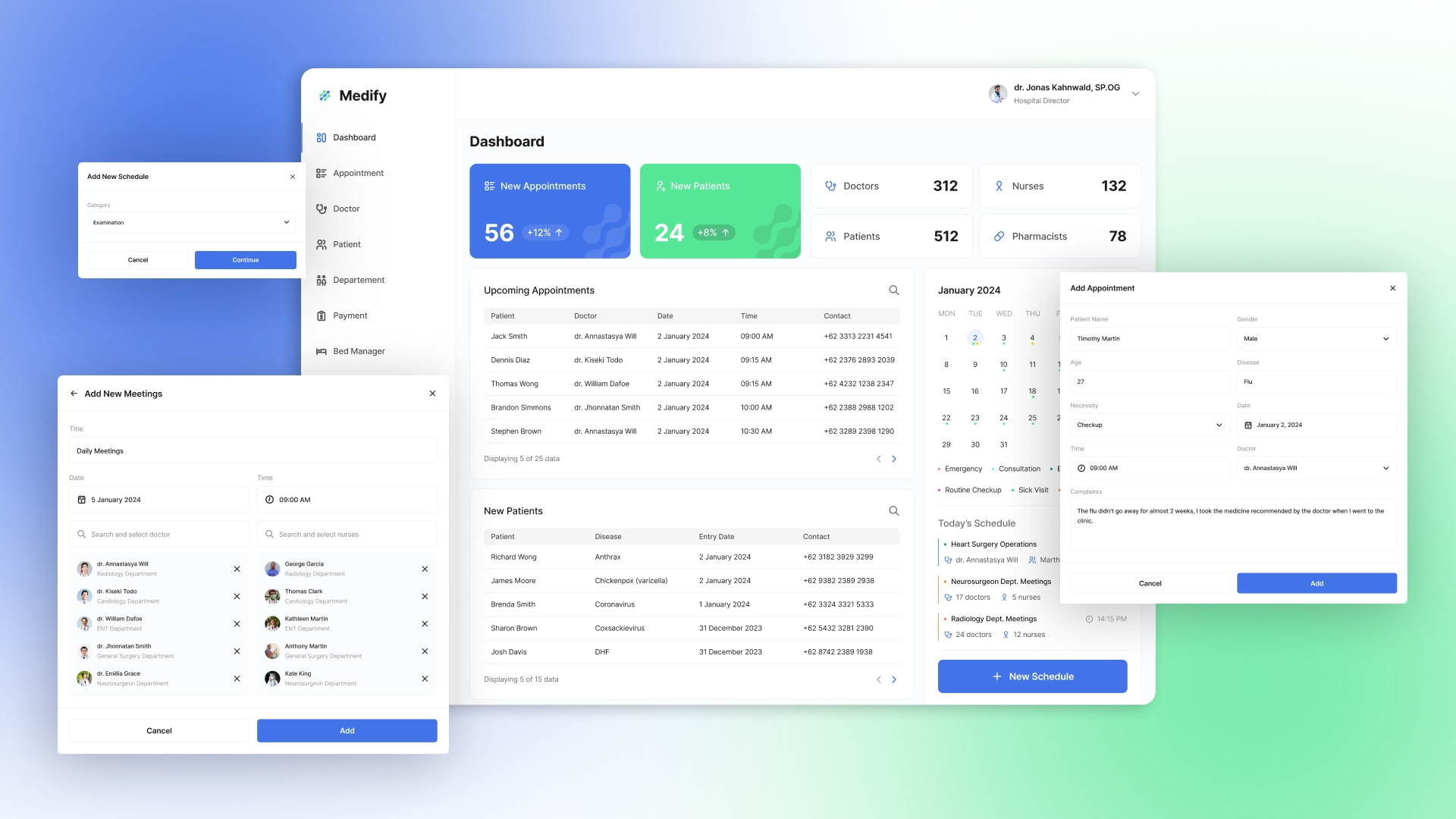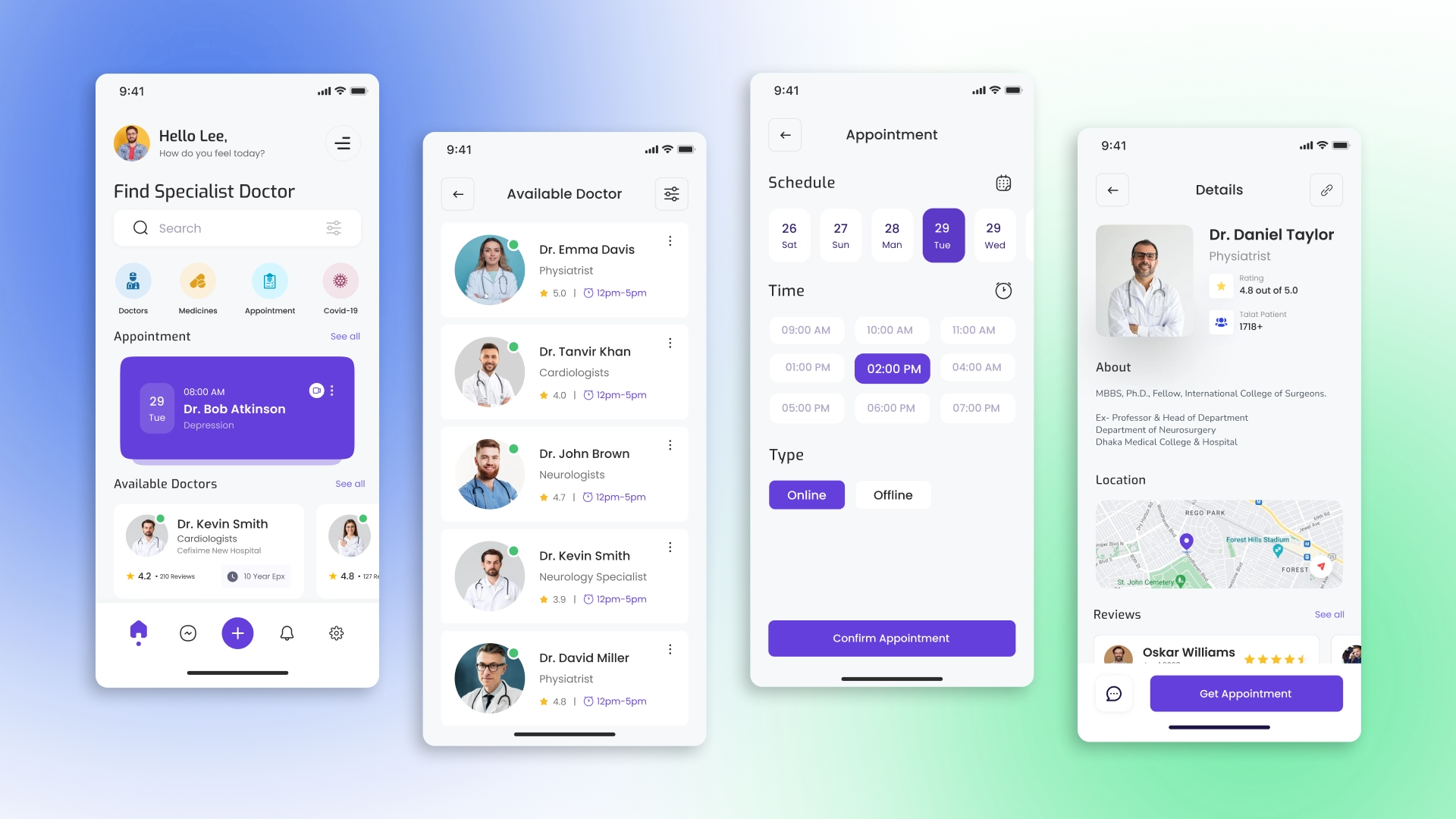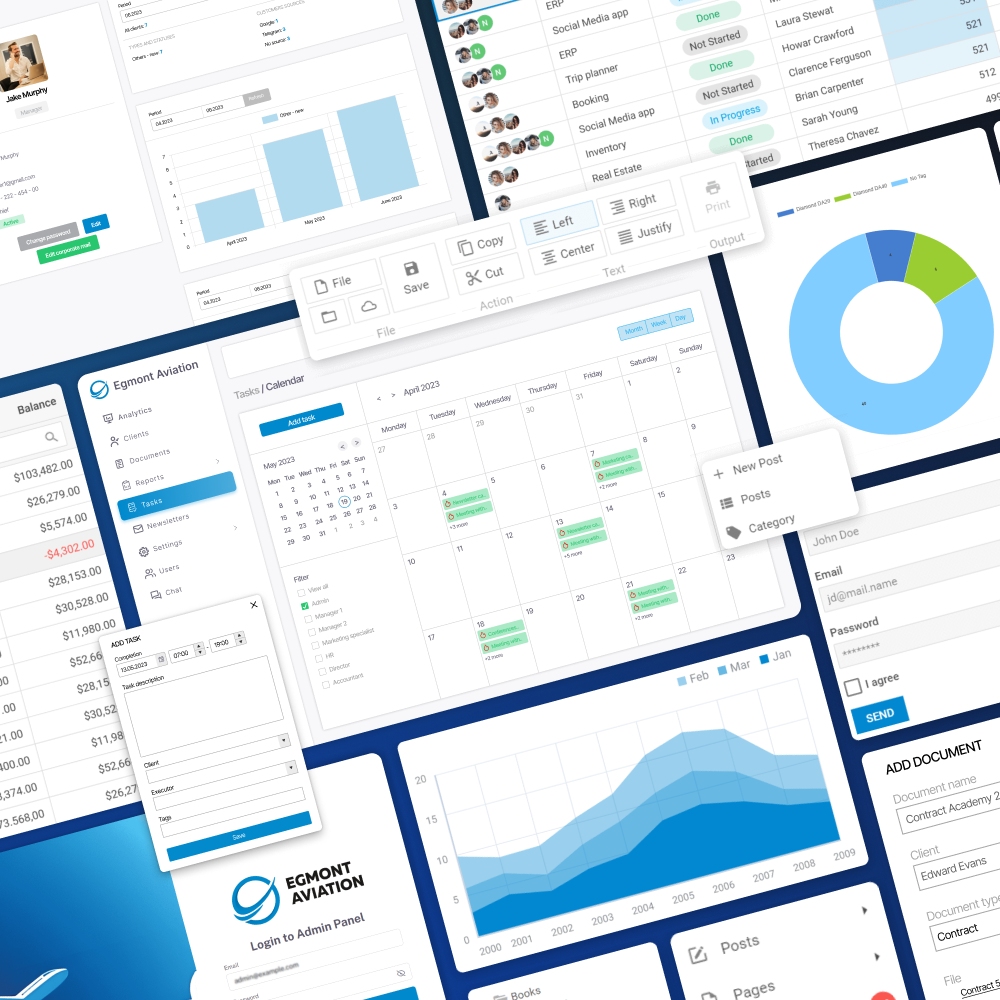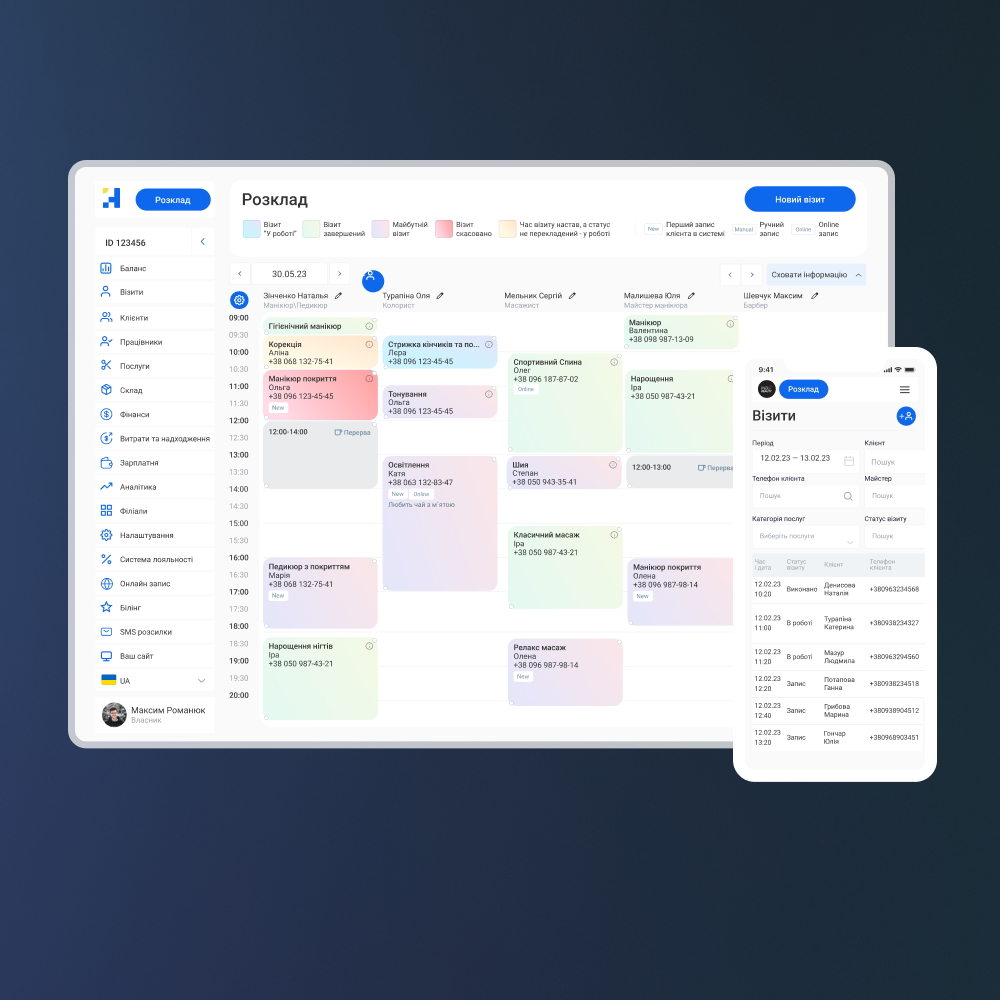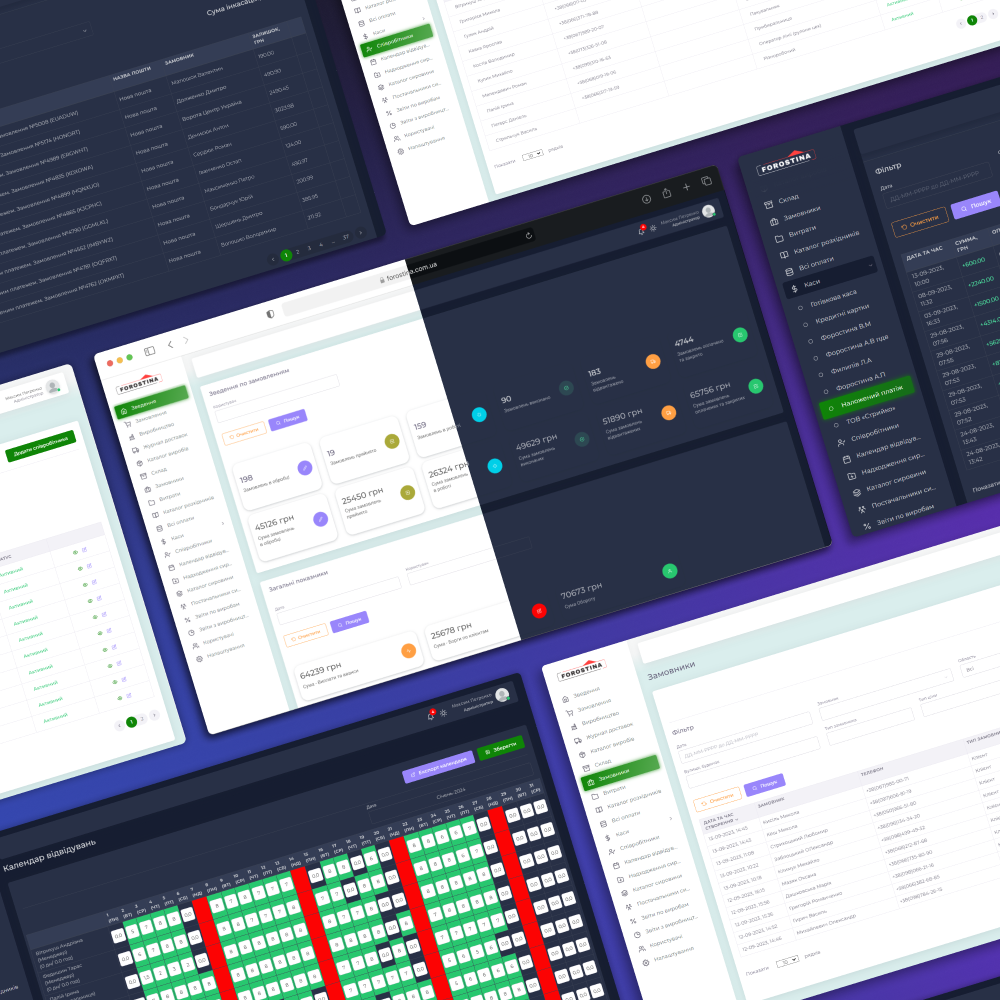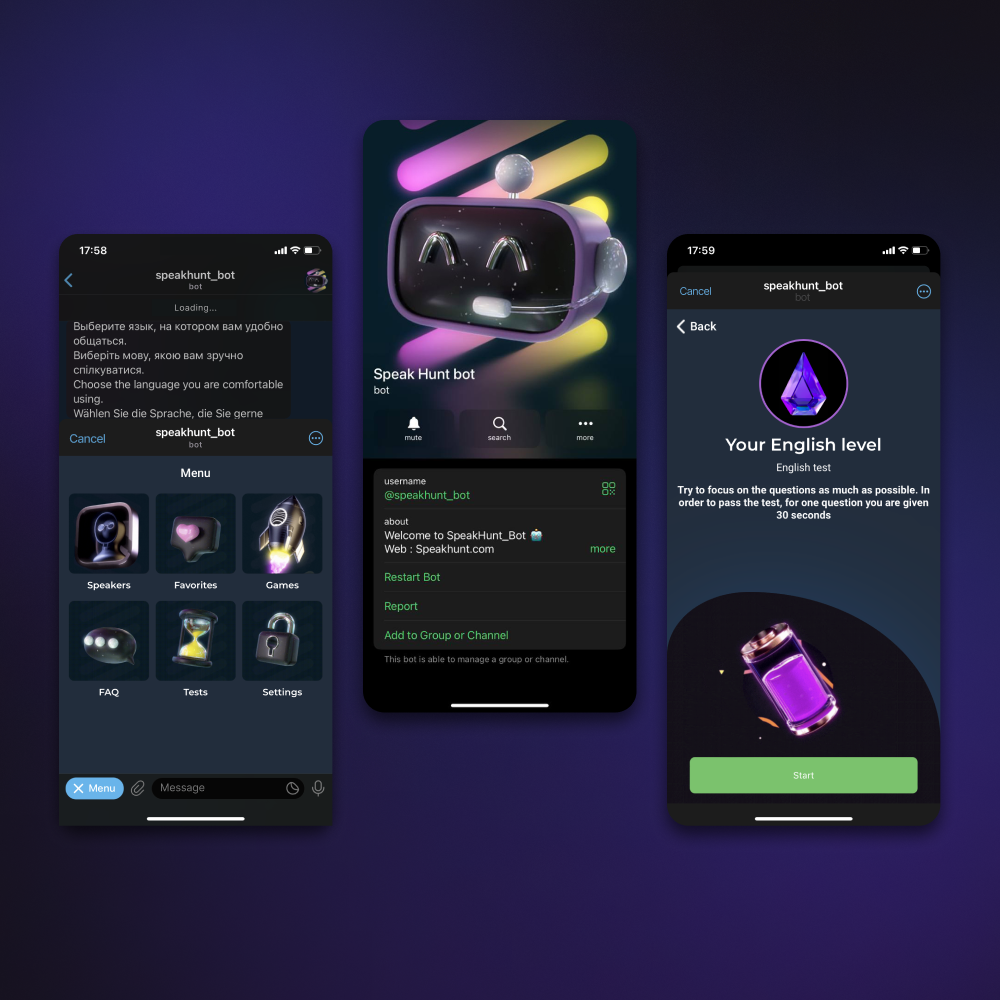







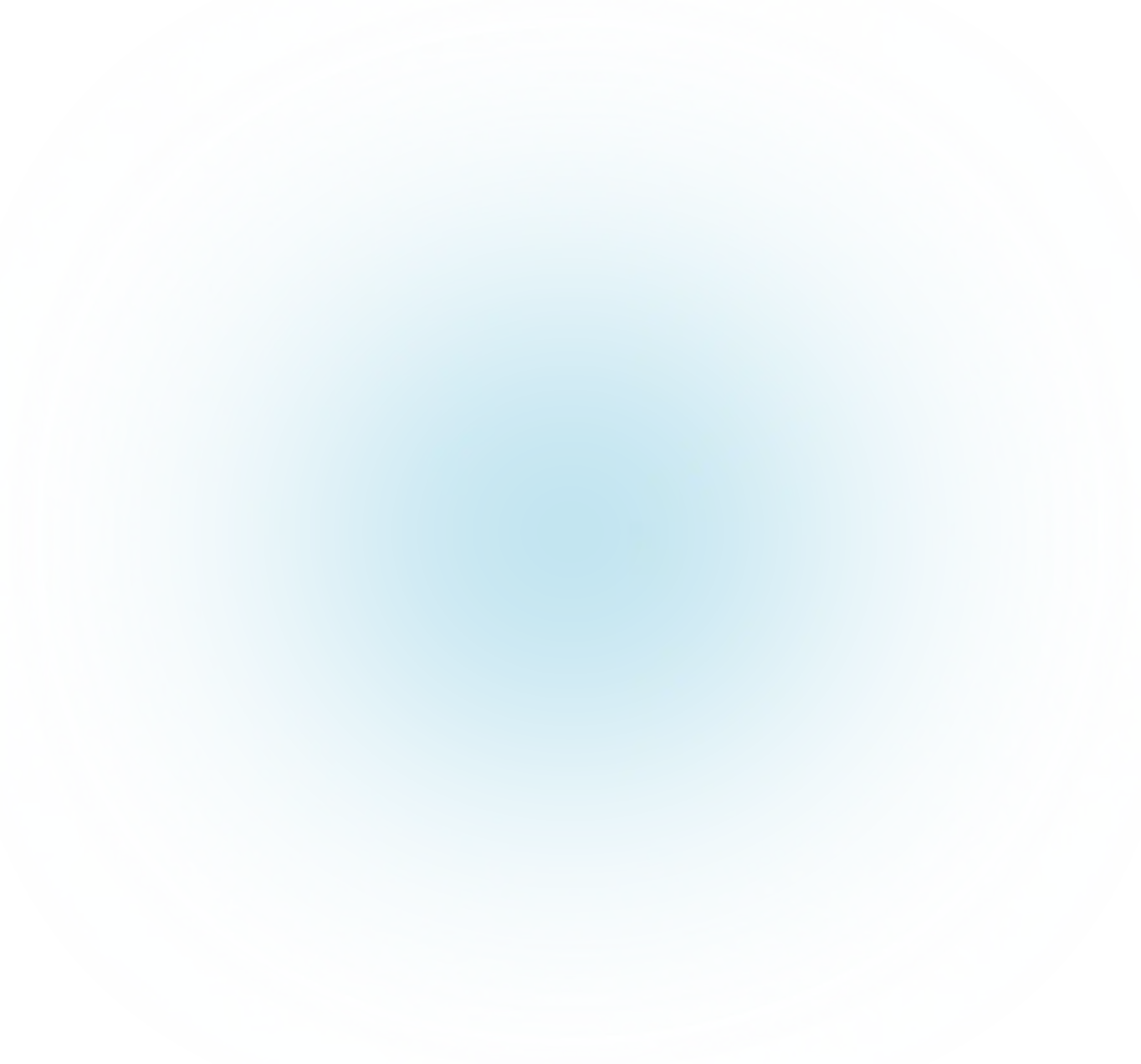

Development of digital solutions for healthcare
Effective management of clinics and pharmacies is the basis for business development and public health.
Breakthroughs in artificial intelligence, IoT, blockchain and AR/VR technologies have led to a rethinking of processes in medical companies. The development of specialized software for medical institutions, such as clinics and pharmacies, is becoming an important tool for increasing the efficiency of their work. Modern digital solutions help healthcare organizations streamline management, improve patient experience, and facilitate administrative tasks.
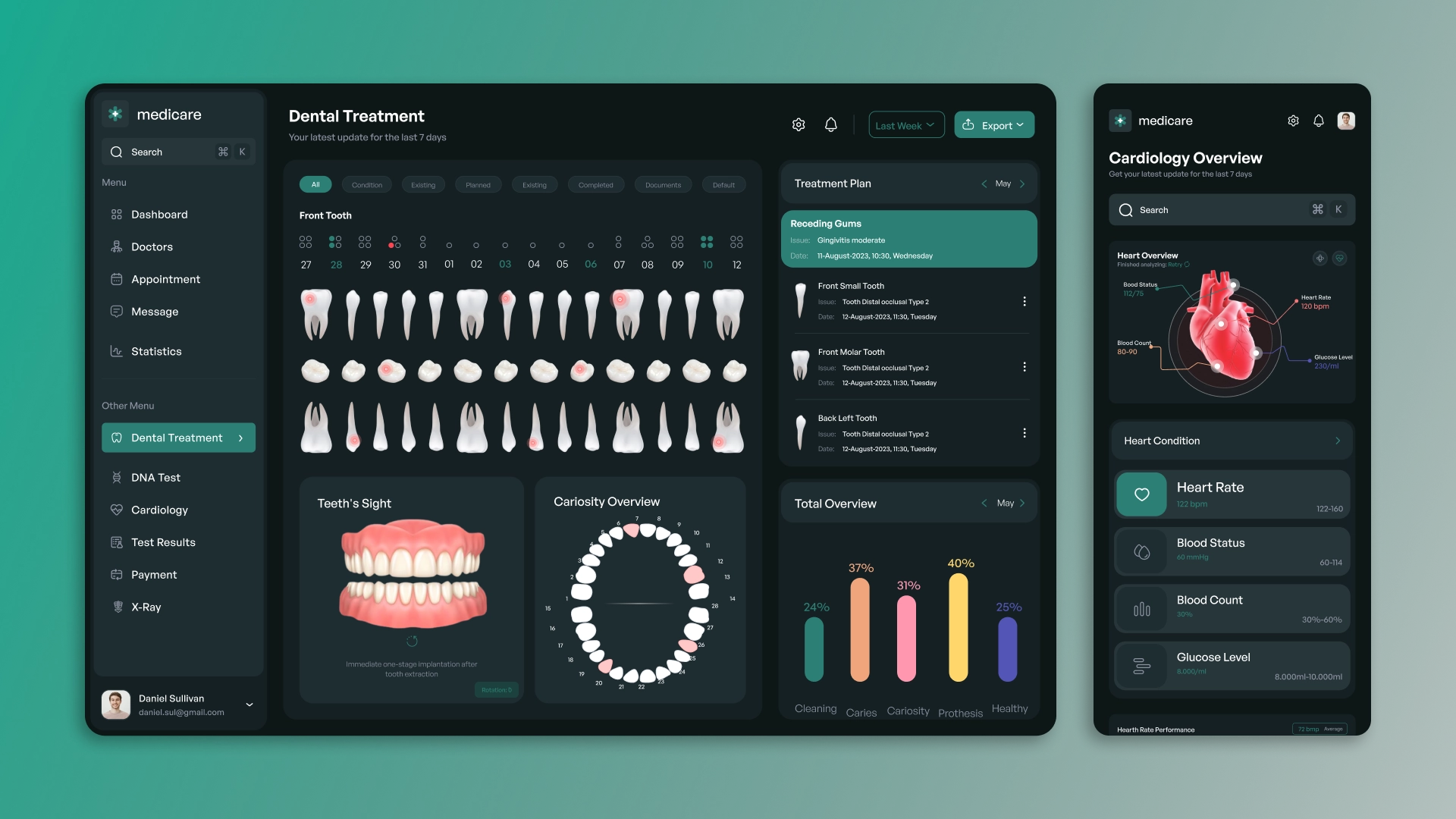
Main Types of Healthcare Software
Each medical software is aimed at solving specific problems in the healthcare sector. Here are the main types of digital solutions that are most popular in the modern market:
- EMR/EHR systems . Used by clinics to store and process digital data about patients. Such data may include dosage and types of medications, previous and planned procedures, visit schedule, consultation history, information about the treatment process, etc.
- CRM systems for medicine . Help automate patient relationship management and improve the quality of care. They provide efficient electronic health record management, appointment scheduling, and physician scheduling management. CRM systems also help improve the efficiency of marketing campaigns and analytics, which allows you to attract new patients and retain existing ones.
- Telemedicine . Telemedicine software allows doctors and patients to interact remotely, which is especially important for remote regions when going to the clinic can be difficult, as well as during periods of epidemics.
- Solutions for medical diagnostics . Allow doctors to share anonymous patient data to fill information gaps and make more accurate diagnoses. Such software often uses artificial intelligence technology to analyze large amounts of data and find patterns.
- Accounting programs . They optimize various administrative and accounting processes in medical institutions, such as maintaining medical records, scheduling management, accounting for medicines and materials.
- Medical Imaging Solutions . It is used for 3D modeling of MRI/CT/PET images, which helps doctors notice the slightest pathologies in the body’s functioning, make more accurate diagnoses and begin treatment of patients in a timely manner.
- Electronic Prescription Software . Many countries have already switched to electronic prescriptions and others are already on this path, making specialized software for prescribing, managing and renewing prescriptions extremely popular and in demand in the market.
- Software for remote patient monitoring . Wearable devices help to remotely monitor the condition of patients online and respond in a timely manner to significant deviations. Typically, Internet of Things (IoT) technology is used to implement such systems.
- Mobile applications for clients . Such solutions allow patients to independently monitor their health status, make an appointment at the clinic and receive consultations online.
Must-have Medical Software Features
Depending on what tasks medical software solves, its functionality may differ significantly. For example, for clinics and hospitals, efficient work with patient data, making correct diagnoses in accordance with current protocols and monitoring drug intake is of primary importance, and for pharmaceutical companies - automation of production management and logistics. Therefore, we propose to consider only the main modules that are most often implemented during individual software development for healthcare:
- Electronic medical record . Individual medical records that store comprehensive information about each patient, including medical history, test results, prescriptions and discharge notes.
- Manage scheduling and appointments . Functionality for recording patients and managing doctors' schedules. It helps optimize clinic operations, avoid queues and reduce waiting times, which improves the quality of customer service and reduces the workload of staff.
- Integration with laboratory and diagnostic equipment . Helps automate the receipt and processing of test data, which significantly speeds up interaction with patients.
- Decision support systems (CDSS) . Ensure compliance with clinical protocols and standards and assist physicians in making diagnoses.
- Medicines management . Functionality for accounting, ordering and managing inventories of medicines and medical goods.
- Health monitoring . Tools for continuous monitoring of the health status of patients, especially for chronically ill patients, with the ability to automatically notify medical personnel of critical changes.
- Medical records management . A module for storing and managing paper medical documentation in electronic form, which ensures the availability of information and improves the organization of work.
Why invest in custom medical software development
Healthcare software development provides many benefits for both companies in the industry and the patients themselves. Let's look at how innovative technologies are transforming the medical field:
- Improving diagnosis and treatment effectiveness . Digital platforms provide doctors with centralized and complete access to patient data, allowing them to see the holistic picture and leading to more accurate and informed medical opinions.
- Patient involvement . mHealth mobile apps can significantly improve treatment efficiency by increasing patient engagement. They send reminders to take medications, help track symptoms, monitor diet or receive online consultations, which makes clients interested in and trust the clinic.
- Cost reduction . By deeply automating and streamlining routine processes such as appointment scheduling, insurance claims processing, and scheduling management, healthcare companies can significantly reduce administrative and operational costs. In addition, this leads to a reduction in human errors.
- Improved coordination . Healthcare software helps in efficient coordination between different specialists and departments, which improves teamwork and quality of care.
- Data Security and Privacy . Customized software solutions provide a high level of patient data protection, in accordance with international and national standards such as HITRUST, HIPAA, GDPR or their equivalents in other countries.
Which companies may need medical software?
Technology is opening up new frontiers for healthcare companies and helping them address a variety of pressing challenges, such as staffing shortages, supply chain disruptions, data availability and security, and patient engagement. Thanks to this, the introduction of innovation has become one of the main trends for most businesses that are in one way or another connected with the medical field.
Here are some examples of how different companies are using medical software right now:
- Hospitals and clinics . Modern software helps medical institutions make more accurate diagnoses and effectively manage interactions with patients and the process of their treatment. In addition, clinics often use software to automate routine administrative tasks.
- Pharmaceutical companies . The introduction of artificial intelligence, as well as innovative visualization and analysis methods, is helping pharmaceutical companies quickly examine huge volumes of anonymized information, identify hidden patterns and conduct deeper research needed to develop new drugs.
- Laboratories and diagnostic centers . Such companies typically use high-tech software to analyze data, manage samples, and automate research.
- Insurance companies . Innovative software solutions using AI and neural networks help companies providing health insurance services more accurately assess risks, process insurance claims and automate the process of paying claims, which allows them to significantly reduce the burden on staff.

Successful examples of using medical software
Today, the market offers a huge number of digital solutions that improve the quality and accessibility of medical services, as well as increase the efficiency of healthcare institutions. Let's look at some of the most successful examples of software:
- Epic Systems . One of the leading providers of electronic health records (EHRs), used by many large hospitals and clinics to manage patient health information, improve care coordination and improve quality of care.
- Teladoc Health . A leader in the field of telemedicine, providing remote medical consultation services. The platform allows patients to receive help from qualified doctors at any time and anywhere, which is especially important during pandemics and for remote regions.
- IBM Watson Health . Uses artificial intelligence to analyze big data in healthcare. Watson helps doctors diagnose diseases, develop personalized treatment plans and predict outcomes.
- Medtronic . Uses software to manage medical devices such as insulin pumps and pacemakers, providing real-time patient monitoring and support that improves patient quality of life and reduces risk.
What technologies and tools are used to develop medical software?
Modern technologies make it possible to create reliable, safe and effective solutions for medical institutions and patients. Let's look at the main tools that AVADA MEDIA engineers most often use in such projects.
- Programming languages . The choice of programming languages depends on the individual needs of each project. For example, Python is ideal for ML, Big Data, AI projects, Java and C# are indispensable when creating large and reliable enterprise systems, and PHP and JavaScript are commonly used in web development.
- Frameworks and libraries . Frameworks help you quickly create reliable and performant digital solutions. For web development, we usually use Python frameworks Django/Flask or PHP frameworks Yii2/Laravel, for creating machine learning and artificial intelligence models - TensorFlow and PyTorch, and for client-side development - Vue/React libraries.
- Database . To store structured information we use SQL databases such as PostgreSQL and MySQL, and for unstructured information we use NoSQL databases such as MongoDB.
- Cloud platforms. To reliably store data, ensure its security and comply with HIPAA standards, we can also use popular cloud platforms such as Amazon Web Services, Google Cloud Platform and Microsoft Azure.
- Internet of Things (IoT). IoT devices and sensors are used to monitor patient conditions in real time. For example, these may include various medical devices, smart bracelets, etc.
- Blockchain . Used for secure storage and transmission of medical data, ensuring their reliable protection from unauthorized access and forgery. In addition, blockchain is indispensable in projects where process transparency is important and in the management of medical records.
- Artificial intelligence . In healthcare software, AI can be used for a variety of purposes, such as analyzing medical images, predicting diseases, and developing personalized treatment plans.
- Augmented and virtual reality . AR and VR technologies are often used in projects related to training medical personnel, conducting virtual operations and patient rehabilitation.

Stages of healthcare software development
Our main goal is to implement effective solutions that the client really needs, which create value for his business and patients, and also help him develop successfully in the competitive healthcare market. To achieve the best result, we build the development process step by step and involve only highly qualified experts in the technical implementation of projects.
Here's how medical software development works in our company:
- Research requirements . We analyze the client’s idea and the needs of his business, conduct market research and determine the optimal concept for future software.
- Design . As soon as we understand the goals and objectives of the software, we begin to develop an interactive prototype, which includes the information and technical architecture of the project, warframes of interface pages and a description of the main functionality. This helps you understand how the intended product will look and function and how users will interact with it.
- Development. At this stage, the technical implementation of fast, reliable and elegant software is carried out: designers create an attractive and functional UI/UX, frontend developers program the client part, and backend developers write functional code and lay down the business logic of the product on the server side.
- QA testing. Quality Assurance Engineers are involved in all stages of a project and their main task is to perfect the product and ensure that it fully meets the client's requirements and is free of technical problems. To do this, QA engineers conduct thorough software testing, identify errors and monitor their correction.
- Launch and development . We deploy software and train client staff to use the new software. Also, to ensure continuous development of the software in the future, we provide technical support services.
Benefits of healthcare software development in AVADA MEDIA
By working with AVADA MEDIA, you get access to the best engineers who combine the capabilities of innovative technologies and their own many years of experience to launch the next generation of medical software. Whatever solution you need, our experts will study your ideas and turn them into a flawless digital product.
Over the years of work in the development market, we have perfectly established internal processes, thanks to which we can guarantee timely delivery of software and its full compliance with your requirements.
We help you solve complex business problems with innovative, reliable and secure digital systems. Contact us by filling out the form below and let's start discussing your project.
Questions and answers
-
What kind of healthcare software do you develop?
We sell a variety of healthcare software, including electronic health records (EHR), telemedicine platforms, patient monitoring applications, and artificial intelligence and machine learning solutions for data analytics and diagnostics.
-
How do you ensure the security of medical data?
We use advanced encryption, authentication and authorization techniques to protect medical data. Our solutions comply with HIPAA standards and other international data security regulations.
-
Can the new software be integrated with existing digital systems in our company?
Of course, during the development of new software, we can integrate it with any external services and databases, ensuring their full compatibility and uninterrupted data exchange.
-
How much does medical software development cost?
The cost of development can vary greatly and depends on several factors: the complexity of the software, for which operating systems the development is being carried out, the expertise of the specialists involved and how many hours they need to spend to bring the product to release. And since each product has unique requirements, it is quite difficult to come up with an accurate price without understanding its specifics.


